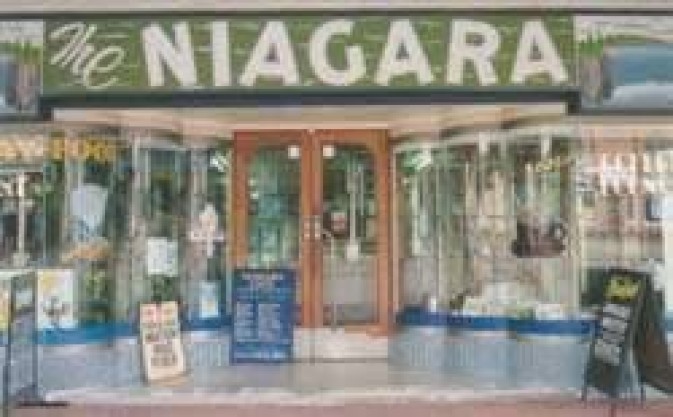Niagara Cafe. Gundagai. NSW.
Greek cafes and milk bars were once a familiar sight in suburbs and country towns throughout Australia. The Niagara Cafe in Gundagai is a rare example of a Greek cafe that has changed little since its refurbishment by the previous owners in 1933. Photograph by Joy McCann.
Beyond the Rolling Wave
Many of our strongest images of Greek immigration are associated with cities - oyster bars, fish & chip shops, milk bars, restaurants, inner city communities - but rural New South Wales was also the destination for many early Greek settlers. In the mid 20th century 43% of Greek-Australians lived in the country. The story of Greek settlers to the State of NSW has been uncovered in a new study by historians Craig Turnbull and Chris Valiotis for the NSW Heritage Office.
Beyond the Rolling Wave: A Thematic History of Greek Settlement in NSW is the result of a partnership between the Heritage Office and the University of NSW to document the contribution of the Greek community to NSW's history and to identify the special places that reflect that history. Craig Turnbull and Chris Valiotis produced the thematic history for the University's Centre for Community History.
Introducing the study, the authors highlight the significant contributions made by Greeks since first arriving in NSW in the 1810s:
"Today, descendants of the earliest arrivals, immigrants and their Australian-born children inhabit vital communities through the state, the inheritors of a vigorous Greek culture secured through the determined efforts of their forebears."
"Greek culture survived in colonial NSW despite the many obstacles encountered by the first immigrants, some of whom, for example, felt compelled to anglicise their names to deflect the xenophobic hostility of numerically dominant Anglo settlers."
In the 19th century many of the Greeks to come to NSW were single men who sought fortune and adventure in NSW. Some came during the Gold Rush, others worked in the pastoralism industry or established businesses in country towns. In the first half of the century many Greek-Australians lived in towns throughout rural NSW being employed in, and often owning, small businesses.
By the eve of WWII this small but steady stream of Greek migrants had produced a stable and vigorous community in Sydney, where an estimated 2,000 to 3,000 Greeks lived in the city and surrounding suburbs. Many in NSW came from the island of Kythera - a pattern of chain migration that was created when successful migrants encouraged friends or family to emigrate.
In the 15 years after WWII the number of Greek-born immigrants living in Australia increased six-fold. Most were semi-skilled or unskilled, but many quickly become self-employed or employers themselves. Greek Australians became small-businessmen, predominantly in the catering trades, although Greeks also worked as general labourers, wharf and maritime workers, hawkers, fishermen, tailors, suburban market gardeners, domestic servants, store and restaurant employees and boarding house operators.
The phenomenon of Greek shopkeeping is personified by John C. Comino, NSW's famous "Oyster King". Ioannis Dimitrios Kominos was a Kytherian and arrived in Sydney in 1884 where he joined his brother Athanasios' new entreprise. Forced to retire from work in a colliery due to ill health, Athanasios had hit on the idea for the business when he visited a fish shop:
"While there, he saw that the Welshman did no more than drop fish into boiling fat, fork it out after a few minutes, slap it on a plate or some paper, and hand it to the customer. After some time watching this, Comino began to think that here was an occupation requiring little experience or hard labour... At all events, he and [friend] Theodore decided to try it, rented some premises and opened a small fish-ship at 36 Oxford Street, sometime in 1878."
Ioannis helped his brother Athanasios with the fish shops and then went on to develop an extensive and complex business supplying oysters to restaurants, fish shops and oyster saloons in NSW. With his own shops and oyster leases he provided a crucial source of employment to young male immigrants.
The story of John Comino is just one part of the rich and complex history of Greek settlement in NSW. Faced with the challenges of creating a new life in a new country, Greek settlers responded in a myriad of ways, but a common thread is the determination of Greeks to sustain traditional cultural forms in NSW. At the same time, they adapted to the society they encountered in their adopted home. The dynamic and distinctive Greek-Australian culture which resulted is part of the rich heritage of NSW.
Beyond the Rolling Wave: A Thematic History of Greek Settlement in NSW is available through the Multicultural Heritage section on the Heritage Office webpage:
www.heritage.nsw.gov.au
Also available in PDF format from
www.kythera-family.net
(Easiest means to find the original entry is to search internally under Rolling).
